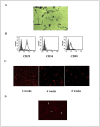Bone marrow derived-mesenchymal stem cells downregulate IL17A dependent IL6/STAT3 signaling pathway in CCl4-induced rat liver fibrosis
- PMID: 30346985
- PMCID: PMC6197688
- DOI: 10.1371/journal.pone.0206130
Bone marrow derived-mesenchymal stem cells downregulate IL17A dependent IL6/STAT3 signaling pathway in CCl4-induced rat liver fibrosis
Abstract
Therapeutic potential of bone marrow-derived mesenchymal stem cells (BM-MSCs) has been reported in several animal models of liver fibrosis. Interleukin (IL) 17A, IL6 and Stat3 have been described to play crucial roles in chronic liver injury. However, the modulatory effect of MSCs on these markers was controversial in different diseases. BM-MSCs might activate the IL6/STAT3 signaling pathway and promote cell invasion in hepatocellular carcinoma, but the immunomodulatory role of BM-MSCs on IL17A/IL6/STAT3 was not fully elucidated in liver fibrosis. In the present study, we evaluated the capacity of the BM-MSCs in the modulation of cytokines milieu and signal transducers, based on unique inflammatory genes Il17a and Il17f and their receptors Il17rc and their effect on the IL6/STAT3 pathway in CCl4-induced liver fibrosis in rats. A single dose of BM-MSCs was administered to the group with induced liver fibrosis, and the genes and proteins of interest were evaluated along six weeks after treatment. Our results showed a significant downregulation of Il17a, Il17ra, il17f and Il17rc genes. In accordance, BM-MSCs administration declined IL17, IL2 and IL6 serum proteins and downregulated IL17A and IL17RA proteins in liver tissue. Interestingly, BM-MSCs downregulated both Stat3 mRNA expression and p-STAT3, while Stat5a gene was downregulated and p-STAT5 protein was elevated. Also P-SMAD3 and TGFβR2 proteins were downregulated in response to BM-MSCs treatment. Collectively, we suggest that BM-MSCs might play an immunomodulatory role in the treatment of liver fibrosis through downregulation of IL17A affecting IL6/STAT3 signaling pathway.
Conflict of interest statement
The authors have declared that no competing interests exist.
Figures










Similar articles
-
Transplantation of human bone marrow mesenchymal stromal cells reduces liver fibrosis more effectively than Wharton's jelly mesenchymal stromal cells.Stem Cell Res Ther. 2017 Jun 13;8(1):143. doi: 10.1186/s13287-017-0595-1. Stem Cell Res Ther. 2017. PMID: 28610623 Free PMC article.
-
Effects of Bone Marrow-Derived Mesenchymal Stem Cells on Hypoxia and the Transforming Growth Factor beta 1 (TGFβ-1) and SMADs Pathway in a Mouse Model of Cirrhosis.Med Sci Monit. 2019 Sep 24;25:7182-7190. doi: 10.12659/MSM.916428. Med Sci Monit. 2019. PMID: 31550244 Free PMC article.
-
The therapeutic effects of bone marrow-derived mesenchymal stem cells and simvastatin in a rat model of liver fibrosis.Cell Biochem Biophys. 2014 Jan;68(1):111-25. doi: 10.1007/s12013-013-9698-1. Cell Biochem Biophys. 2014. PMID: 23807535
-
Therapeutic efficiency of bone marrow-derived mesenchymal stem cells for liver fibrosis: A systematic review of in vivo studies.World J Gastroenterol. 2020 Dec 21;26(47):7444-7469. doi: 10.3748/wjg.v26.i47.7444. World J Gastroenterol. 2020. PMID: 33384547 Free PMC article.
-
STAT3: A key regulator in liver fibrosis.Ann Hepatol. 2021 Mar-Apr;21:100224. doi: 10.1016/j.aohep.2020.06.010. Epub 2020 Jul 21. Ann Hepatol. 2021. PMID: 32702499 Review.
Cited by
-
Lipid Disorders in NAFLD and Chronic Kidney Disease.Biomedicines. 2021 Oct 6;9(10):1405. doi: 10.3390/biomedicines9101405. Biomedicines. 2021. PMID: 34680522 Free PMC article. Review.
-
Mesenchymal stromal cells promote liver regeneration through regulation of immune cells.Int J Biol Sci. 2020 Jan 22;16(5):893-903. doi: 10.7150/ijbs.39725. eCollection 2020. Int J Biol Sci. 2020. PMID: 32071558 Free PMC article. Review.
-
A Novel Bifunctional Fusion Protein (Anti-IL-17A-sST2) Protects against Acute Liver Failure, Modulating the TLR4/MyD88 Pathway and NLRP3 Inflammasome Activation.Biomedicines. 2024 May 17;12(5):1118. doi: 10.3390/biomedicines12051118. Biomedicines. 2024. PMID: 38791080 Free PMC article.
-
Molecular Pathways Modulated by Mesenchymal Stromal Cells and Their Extracellular Vesicles in Experimental Models of Liver Fibrosis.Front Cell Dev Biol. 2020 Dec 8;8:594794. doi: 10.3389/fcell.2020.594794. eCollection 2020. Front Cell Dev Biol. 2020. PMID: 33425900 Free PMC article. Review.
-
Comparative Histological Study of Therapeutic Effect of Mesenchymal Stem Cells versus Mesenchymal Stem Cells Co-Cultured with Liver Tissue on Carbon Tetrachloride-Induced Hepatotoxicity in Adult Male Albino Rats.J Microsc Ultrastruct. 2022 Aug 18;11(4):225-236. doi: 10.4103/jmau.jmau_62_21. eCollection 2023 Oct-Dec. J Microsc Ultrastruct. 2022. PMID: 38213650 Free PMC article.
References
-
- Friedman S. Liver fibrosis: from bench to bedside. Journal of hepatology Supplement. 2003;38(1):38–53. - PubMed
MeSH terms
Substances
LinkOut - more resources
Full Text Sources
Medical
Molecular Biology Databases
Research Materials
Miscellaneous

